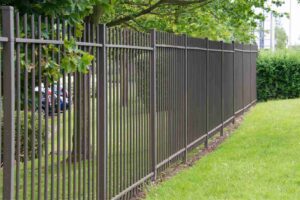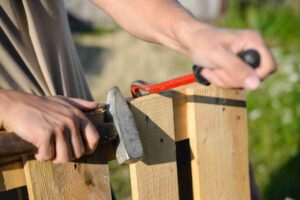How to Fix a Leaning Wooden Fence
Is your once-sturdy wooden fence starting to lean? Don’t worry! In this guide, we’ll break down how to fix a leaning wooden fence with easy-to-follow steps using the right tools.
In this blog, we’ll learn how to assess the damage and identify common causes like soil erosion and weak posts. We will also run you through preventive measures and maintenance tips from our professionals to keep your fence standing strong for years.
How to Fix a Leaning Wooden Fence
Let’s learn how to fix a leaning wooden fence by assessing the damage, getting the tools, and then going step-by-step.
If you want more information on repairing a metal, vinyl, or chain link fence, check out our ultimate fence repair guide.
Assessing the Damage
The first step is to assess the damage. Look to see if the damage has been caused by natural causes and time or by external factors and trauma. Fixing a fence that is damaged because of rain water erosion is a lot different than a fence that has been damaged by kids practicing soccer.
Here are the common causes of your fence leaning below:
- Soil Erosion – When there’s too much rain, melted snow, or flooding, the ground can turn wet, soft, and susceptible to shifts, posing a risk for wooden fence posts to rot. Remember that different soil types have varying levels of stability.
- Weak or Damaged Posts – Moisture can lead to decay and rot in wooden fence posts, making them soft and damaged. When the posts lean, the panels also follow in a domino effect.
- Incorrect Installation – Fencing companies often see this problem later on after a fence was incorrectly installed, especially by first time installers. The fence leans either because the fence posts were not buried deeply enough or because they were not spaced properly.
Step-by-Step Repair Process
Now that we’ve identified the common issues that cause a fence to lean, here’s a step-by-step guide below.
Materials and Tools Needed:
- 2×4 braces
- Tamping bar
- Miter or circular saw
- Drill
- Screws
- Concrete
- Tape measure
- Scrap wood sheet
- 3 ½-inch screws
Steps:
- Clear away any obstacles, like vegetation or tree roots that might push against the fence and cause it to lean.
- Use 2×4 braces to bring the fence back to a vertical position. Reconnect the rails to secure fence posts using three 12-inch screws. Use a reciprocating saw to remove any nails blocking the rails from aligning with the post.
- Identify posts that are not properly anchored and lack sufficient ground support; this is a common cause of fence leaning. Strengthen the foundation through these steps below to address loose posts, opting to preserve the original post:
- Excavate a hole around the leaning post, ensuring sufficient depth and width for proper support.
- Fill the hole with concrete or gravel, compacting it thoroughly for a stable base.
- Reinsert the post, ensure it is level, and allow the concrete to set according to the manufacturer’s instructions.
- Introduce a new post adjacent to the original one that requires securing.
- Dig a deep, narrow hole in the ground. Cut a 4×4 fence post with a circular saw and fasten rails to the new post using three 12-inch screws.
- Pour concrete around the new fence post and let it fully harden.
- Remove braces and reattach or replace any pickets that were temporarily removed in the process.
- Check that the panels are level and properly aligned and that the fence appears stable.
How Do You Straighten a Fence Without Removing It?
You might wonder how you straighten a fence without removing it. While the above steps are recommended for any leaning fence, there is a temporary fix. To prevent the post from leaning further, push the fence back straight and use a piece of wood as a brace between the fence and the ground to support it temporarily.
Another temporary fix is you can break the old concrete footing with a sledgehammer and chisel. Drive a stake into the ground, apply the bracing method explained earlier, and reinforce it by screwing the stake to the brace. Finish the process by clamping the post to the brace.
Preventive Measures to Avoid Your Fence from Leaning
Here are some valuable tips from our professional fence experts to prevent your fence from leaning in the future:
Managing Soil Erosion
- Avoid placing sprinklers near fence posts to prevent soil loosening.
- Implement proper drainage solutions in the surrounding area to minimize the effect of erosion.
Choosing High-Quality Materials
- Opt for pressure-treated wood, especially in high-moisture regions, to resist decay and insects.
- Consider using cedar or redwood, as these materials are less prone to rot.
Ensure Correct Installation
- Align fence posts properly during installation to maintain stability.
- Maintain even spacing between posts and incorporate cross-bracing for added support.
- Double-check the alignment during installation to prevent sagging and potential leaning issues.
Regular Maintenance
- Check your fence often for damage or wear, like loose boards, chipped paint, rot, or bugs. If you spot any problems early, you can fix them right away.
- Climbing plants may look nice but can harm your fence and make it lean due to added weight. Trim the plants and don’t let them cover the whole fence to avoid moisture buildup and possible decay.
- Watch out for termites and other bugs that can harm your wooden fence. Check regularly for signs of termites, and consider getting pest control help if necessary.
Ask for Professional Help
- To get the job done right, it’s best to leave it to the experts and contact your fencing company for professional services to ensure a secure and stable fence for the long term.
- Professional services from your fencing company include proper installation techniques, using quality materials, and addressing specific issues like soil erosion.
Conclusion
In conclusion, we’ve walked through the entire repair process for a leaning wooden fence, covering everything from identifying causes like soil erosion, weak posts, and incorrect installation. Timely maintenance is critical to preventing future problems, so regularly inspect and address any wear or damage. Proactive maintenance ensures the longevity and stability of your wooden fence. Remember, a little care today can save you from more significant repair challenges in the future.


